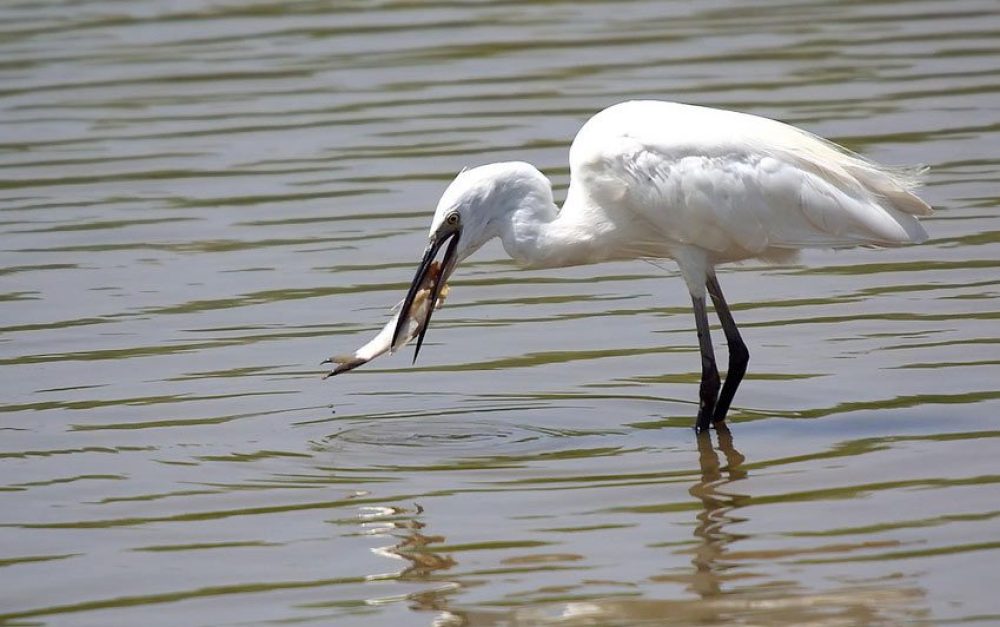EPA recently released its assessement of the ecological risks posed by the widely used herbicide atrazine. Agency scientists found that current exposures greatly exceed its “levels of concern” for chronic risk for birds, mammals and fish — by 22, 198, and 62 times, respectively. When it comes to wildlife harms, these new findings on atrazine are pretty damning.
EPA recently released its assessement of the ecological risks posed by the widely used herbicide atrazine. Agency scientists found that current exposures greatly exceed its “levels of concern” for chronic risk for birds, mammals and fish — by 22, 198, and 62 times, respectively. When it comes to wildlife harms, these new findings on atrazine are pretty damning.
This Ecological Risk Assessment (ERA) is a step in the agency’s long overdue evaluation of the risks posed by atrazine. EPA is conducting these reviews as part of the re-registration process for pesticides, which takes place about every 10 to 15 years. Next up will be the human health risk assessment, which is expected by the end of this year.
An endocrine disruptor in the water
Atrazine is a controversial herbicide (and yes, an herbicide is definitely a pesticide) that is often used as a pre-emergent on cornfields, meaning it keeps weeds in check before they can sprout.
Among atrazine’s more notorious physical properties are its mobility and persistence in the environment, according to EPA. When used as a pre-emergent pesticide it often washes off fields with spring rains, to such an extent that atrazine is the most frequently detected herbicide in U.S. streams. Atrazine can then make its way into our drinking water, and is especially prevalent in surface water in the Midwest, where millions of pounds of atrazine are applied every year.
Atrazine is recognized to be an endocrine-disrupting compound (EDC) that can disrupt hormonal systems at low levels of exposure. The herbicide has been linked to a number of health harms in animal models, but one well-known effect is the disruption of development of the male gonad, with evidence coming from fish, reptiles, amphibians, birds, and mammals.
Atrazine became particularly famous after UC Berkeley professor Tyrone Hayes began to speak out about his findings that endocrine disrupting effects in amphibians occurred after low-level exposure to atrazine. Other scientists have independently found parallel results. Following release of his findings, Dr. Hayes reported personal attacks from atrazine’s maker Syngenta that have continued for many years. Full disclosure: I studied with Dr. Hayes as an undergraduate many years ago, and have great respect for his work as a biologist, mentor and teacher.
Meanwhile, in Europe . . .
Speaking of endocrine disrupting compounds, let’s talk about what’s going on in Europe for a moment. The European Commission (EC), which is the executive branch for the European Union, just released a long-delayed proposal for how EDCs should be defined. This step — defining criteria for EDCs — potentially allows for their regulation, since a definition must be agreed upon before any regulations can be put in place.
The ruling was expected back in 2013; I wrote a blog about it then. But intensive lobbying by the chemical industry led the initial proposal to be set aside. Over the past few years, complaints from Sweden and the President of the European Parliament have been submitted to the EC about this delay. According to Nessa Childers, a member of the European Parliament from Dublin, Ireland, “the choice to listen to the pesticides industry has led to years of temporising and obfuscation.”
This obfuscation means that rules that might protect the public from these chemicals of concern have been put on hold. Unfortunately, according to PAN Europe, the revised proposal for new criteria will essentially result in EDCs not being regulated. Those criticizing the new rules argue that it places an “impossibly high burden of proof of public harm.” As we and many other groups have said for years, that burden of proof should be on the chemical manufacturers, not public health agencies.
This latest development on EDCs won’t directly affect the regulation of atrazine in the EU, by the way. The herbicide was taken off the market in Europe back in 2003 due to concerns about water contamination and the resulting human health effects.
Time to be cautiously optimistic?
So what’s the next step here in the U.S.? Having studied endocrinology, I believe it’s very clear that we should not be using atrazine given its endocrine disrupting properties and propensity to get into drinking water. Plus a 2011 Scientific Advisory Panel on atrazine convened by EPA raised concerns over the herbicides’ links to certain types of cancer, calling into question EPA’s conclusion that atrazine is “not likely” to be a human carcinogen.
Over the years, advocacy groups have critiqued EPA’s position on atrazine for a number of reasons, including and especially their lack of reliance on sound science from independent researchers. In this recent ERA, the agency seems to be bringing in more of these independent findings — basically, doing more of the job we say they should be doing. This is a very good thing.
I’ve read in news articles some speculation that the risks to wildlife highlighted in the ERA are now so great that the only reasonable outcome is effectively banning atrazine’s use. The cynic in me says, “Don’t hold your breath — this is the second biggest herbicide in the country.” But I’m cautiously optimistic. We’ll be watching closely when EPA releases its human health risk assessment of atrazine later this year. Let’s see how this unfolds.
Photo: Ferran Pestaña | Flickr








